|
FAQs about Sea Cucumber Identification
4
Related Articles: Sea
Cucumber, Marine
Scavengers, Sand Sifters
Related FAQs: Cuke
ID 1, Cuke ID 2, Cuke ID 3,
Cuke ID 4,
Cuke ID 5, Cuke ID 6,
Cuke ID 7, Cuke ID 8,
& Sea
Cucumbers 1, Sea Cucumbers
2, Cuke
Behavior, Cuke Compatibility,
Cuke Selection, Cuke Systems, Cuke Feeding, Cuke Disease, Cuke Reproduction,
|
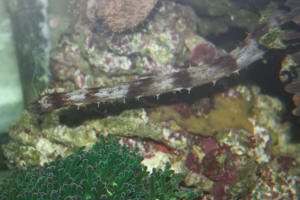
|
|
Sea Cucumber ID 1/12/13
I was pretty sure that this is a Donkey Dung Sea Cucumber. I find myself
second guessing this however. I mainly want to know if this is a sand
sifting detritivore for sure if nothing else. I have been looking through
the FAQs and will continue to do so. Thank you for the awesome work you all
do. BTW this Cucumber is approximately an inch long fully inflated.
<Is a Sandsifter (most all Cukes are), does look like a Donkey Dong... a
good size to start with/have. Bob Fenner>
|
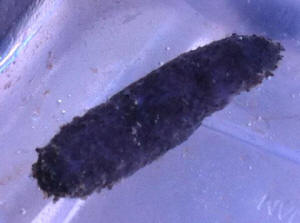
Re: Sea Cucumber ID 1/14/13
Hello again and thank you for the prompt reply. :) I am wondering if
Holothuria Mexicana is known to burrow all the way into the sand
occasionally.
<Mmm, not as far as I'm aware, no; perhaps when it's very small, as yours is
currently>
It seems mine has gone under the sand. It must still be doing ok since I
see no ill effects and it has been about 12 hours since I last saw it on top
of the sand. I am also wondering if there is a place I can find that details
the growth rate of Holothurids in general. Thank you as always.
<Am very sure there are such data in the scientific literature. Some notes
on searching here:
http://www.wetwebmedia.com/litsrchart.htm
Terms to be used in computer/bibliographic searches: "Holothuroids, growth,
length/age ratio, chart/s..."
Bob Fenner>
|
Clear tube worm identification 11/17/12
Hi,
<Frank>
I like your website and I hope you can help me out. I was lifting a
few pieces of live rock to see if my red banded Longfin Basslet was still alive
(yes i found him nice and healthy). However, I came across this clear
tubed animal. He has small tentacles for his mouth are and stretches
around 2 inches. He has a digestive tract that you can see. I
removed him and put him in a holding pen in my sump. The picture enclosed
is the best picture I can send you. Please let me know if you can identify this
mysterious creature (I hope he is safe to put back in my dt)
<Mmm, this appears to be not a worm, but a sea cucumber... Not problematical...
I'd put it back in your tank and enjoy it. Bob Fenner> |
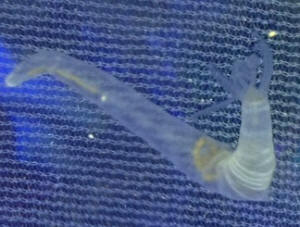 |
|
identification? Cuke... rdg. 10/19/11
Dear Wet Web Media Crew,
I have a 120gal Salt water setup, I recently purchase<d> a
new frag and just noticed that a spiny sea cucumber has tagged
along. From what I have read these are bad news for a tank if
they die?
<Mmm, no; not necessarily. Read here: http://wetwebmedia.com/cukecompfaqs.htm
I am attaching a photo to make sure that I indeed do have a sea
cucumber, and if you recommend that I remove it from my tank?
Thanks for your time,
Chris
<Read on! Bob Fenner>
|
|
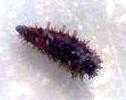
|
|
Cucumber species ID 3/19/11
Hi WetWebMedia crew,
<Peter>
Thank you for taking the time to read this. I have a question
about a sea cucumber I purchased recently. I searched your site
for an ID for this guy and all I found resembling the cucumber I
purchased was a pic of a starfish pooping out a blob and it later
reforming into a cucumber. Very interesting, that email :).
Anyways, it looks the same as the one I have. Can you ID this
cucumber based on these photos I have attached? It is definitely
a sand sifting variety and poops out really clean, white sand;
definitely not a filter feeder. Currently, he is about 3-4"
long though that does not mean much as I know some can get quite
large.
<Agreed>
You guys must get tired of sorting out all the e-mails you get
each day; I really appreciate all of your work.
Thanks again,
Peter
<This looks to be some species of Parastichopus/Stichopus
(Family Stichopodidae)... it may be an aberrant specimen
(discolored let's say)...
I do hope it is not a temperate species, being sold as a
tropical. I would ask the folks you bought it from where it was
collected. Bob Fenner>
|
|
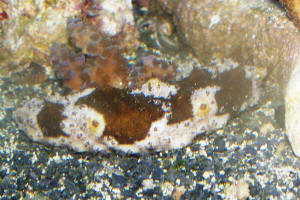 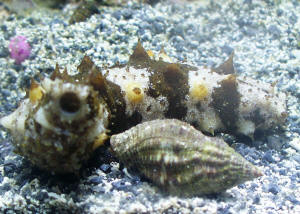
|
|
Re: Cucumber species ID-- 03/20/11
Mr. Fenner,
<Hey Peter>
Thank you for replying to my e-mail. I think you are right and it
would be best to ask the LFS where this came from. But I think it
possibly my be a Holothuria floridana.
<Mmm, the colour/pattern is similar... as is Thyonella
gemmatum, but not the tubercles
("spikiness")...>
I Googled some images of that particular species and some of the
pictures looks like a dead match. Thankfully, it is not a
temperate species and this particular cucumber doesn't get
too big. I cannot imagine a two foot cucumber in my tank!
Thank you,
Peter
<Thank you for this follow-up, your further input.
BobF>
|
|
Hello, I've found another new
critter. 2/5/11
As I'm sure you may be getting used to from me. This one is a
cucumber, brownish green upper body, pink belly with black and
yellow feeding appendages.
<Ah yes>
this picture is the best I could get at the time, hopefully after
tomorrow I will have a better one for you. Currently he is about
1" with tentacles outstretched. I'm sure he is harmless,
but I'm interested in his species, mature length, dietary
requirements and what night.
Krystal
<Mmm, don't know, but if it "appeared" out of
nowhere, there is likely sufficient foods in your rock, substrate
to support it. Bob Fenner>
|
|
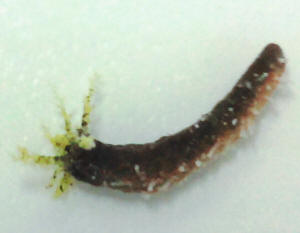
|
|
Worm ID: Likely Synaptid Sea Cucumber --
8/17/10
<Hello Jen, Lynn here today.>
Good day to you!
<Thank you, and you as well!>
I have an interesting worm that I can't seem to find an ID
on.
<I see it and guess what? It's actually a variety of Sea
Cucumber/Holothuroid, mostly likely in the family Synaptidae.
These Cukes are mostly nocturnal, 'moppers'/deposit
feeders that consume organic detritus or sponge secretions. They
do best in large, mature systems but can be offered sinking
pellets as a supplement to their diet. Rob Toonen recommends
dropping a sinking shrimp pellet near the Cuke just before the
lights go out, as this will give the pellet time to soften before
the Cuke begins to actively feed. Regarding size, some Synaptids
can get quite large (5-6 feet/1.5-1.8 meters), however, most seen
in aquaria remain comparatively small. Overall, they're
peaceful but can fall victim to roving hermits.>
I've checked your site and just about every way I can think
of naming it through Google as well. Perhaps you can help?
<Yep, I haven't seen one of these neat little fellows in
quite a while, so I'm more than happy to help!>
These worms were found in the live sand from a tank we recently
purchased.
<Nice>
When we transported everything to our house, I noticed that these
guys were resting on top of the sand in the buckets and figured
they were dead. We got
everything set up and once done, these guys came back to life.
They started to burrow in the sand and by the next day they had
their mouths sticking out with almost tentacle-like
appendages.
<Yep, what you're seeing are the feeding
tentacles/appendages. Synaptid Cukes tend to feed either from a
stationary position, reaching out from within a rock crevice or
sediment burrow, or while actively moving around. Either way,
they can move surprisingly fast when it comes to retracting back
into their burrow/crevice or making a quick getaway.>
I've attached a few pics as well as a link to a video of what
these guys look like. The close up photo isn't very well
done.
<No worries, the combination of photos/video you supplied is
enough to be able to offer that what you have is definitely a
Cuke, and most likely a Synaptid. Besides, trust me, I've
seen photos so blurry/small, that you could hardly distinguish
the rocks from the subject at hand! What you sent is just
fine.>
The big red arrow is pointing towards his mouth (lighter circle
with two black appendages coming out. And the smaller arrows
point to the tentacles surrounding its mouth.
<Thanks>
They seem like they just filter feed,
<Although there are filter-feeding Cukes, Synaptids are
actually deposit feeders, grabbing bits of food from surrounding
surfaces. The most obvious difference between the two involves
the feeding tentacles (since many times that's all you can
see). In lieu of a ring of relatively simple tentacles (like your
individual has), those of filter-feeders generally appear
elaborately branched, feathery, and delicate. The tentacles bring
bits of captured food to the mouth by curling in on themselves,
one at a time, then unfurling back into the water.>
..but their appearance almost makes me wonder if their tentacles
resting on the sand bed and outreached
<Typical position>
..like they are at night could possibly be some sort of predatory
worm?
<Nah, what you have is fairly harmless, even though it's a
Cuke. Normally, when a hobbyist finds out they have a resident
Sea Cucumber, the first thing that goes through their mind is the
dreaded 'Cuke-nuke'. That's when a stressed or dying
individual spews its innards and releases a toxin that can wipe
out a system. Sea Apples are beautiful, but notorious for this.
What you have on your side is the fact that Synaptids lack the
potentially devastating Cuvierian tubules that other Cukes
possess. That's not to say though that what you have is
completely harmless. These Cukes likely have their own defense
system that makes them taste bad (or otherwise discourages
predation), and if you have quite a few, and they all die, you
could have an issue with ammonia. One thing you might want to do
(for right now, anyway) is to run some carbon just in case,
mainly because there may be some die-off (and ammonia build-up)
as a result of the move. Be sure to keep an eye on your water
parameters and be ready to perform some water changes if/when
necessary.>
Any insight on these guys would be greatly appreciated!
<For more information, please see the following links:
http://www.wetwebmedia.com/seacukes.htm
http://www.advancedaquarist.com/issues/nov2002/invert.htm
>
Thanks!
<You're very welcome!>
Jen
YouTube Video: http://www.youtube.com/watch?v=sf7S6p1PcBM
<Take care, Lynn Z>
|
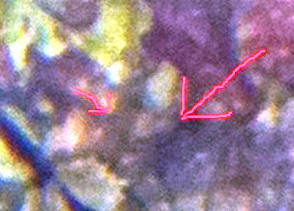 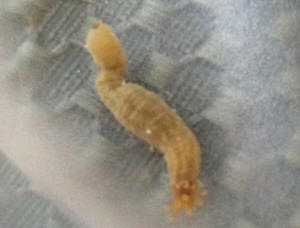 |
|
Sea Cuke identification -- 2/23/10
Hello to whoever is kindly responding!
<Howzit Joe?>
My name is Joe and I'm a student at the Sound School of
long island sound in New Haven CT, And I was wondering if
you could help me identify this Cuke one of my friends
purchased at his LFS (without researching! AHHHH) and
placed in his reef tank. I hope this attached jpeg. can
help though the quality isn't 100%. I'm also
wondering if it's time to remove I'm from the tank,
because he hasn't been acting or looking normal.
He's in a 300 gallon with two giant clams a yellow tang
some hermits and an infestation of tiny snails along with
other less aggressive fish . He has a basic sump for a
filter. The Cuke has slowed down a bit but it looks like
he's just enjoying the local grub (the sand seems to be
his size) but I've also noticed tons of tiny white
worm-like critters all over his back that appear to be
enjoying the Cuke as grub, and he's got a good mound of
feces going.
There's also a hermit crab who crawls on the Cukes back
and starts to pick at it. I'm worried the Cuke might
get a bit annoyed and excrete the infamous innards. There
was also a recent alkalinity crash in the tank we can't
explain too well. Thanks for your time
Joe
<Mmm, looks to be a Stichopodid... maybe Stichopus
chloronotus... of moderate use/safety when small... Bob
Fenner>
|
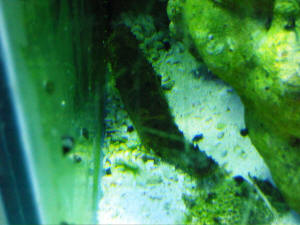 |
Urchin ID: Family Toxopneustidae --
2/9/10
Hi,
<Hello Greg, Lynn here this evening.>
I just noticed this hitchhiker urchin a couple of days ago.
<What a beauty!>
I saw him again today during a water change, plucked off his
'decorations' and snapped a picture. I'm wondering if
you could possibly ID him,
<I'll certainly try. It looks like a neat little urchin in
the family Toxopneustidae. If it came from the waters of the
Western Atlantic or Caribbean, it's probably a common species
known as Lytechinus variegatus. Although the common name is the
green urchin, color varies considerably. This species, along with
at least one subspecies, ranges from North Carolina all the way
down to Brazil, and is also found in Bermuda. Potential size
(diameter) at maturity is ~4' with spines, ~3' without.
These urchins are known for having numerous specially adapted
tube feet called globiferous pedicellariae capable of
envenomating you, so look, but do not touch! You can see the tube
feet in your photo; they're the translucent, flexible
structures interspersed among the spines. In addition to defense,
the urchin uses these tube feet to cover itself, and hold in
place, bits of shell, sea grass, debris, etc. As far as diet,
these urchins apparently love sea grasses such as Thalassia, but
are fairly omnivorous, eating algae as well as meatier fare. For
more information, please see the following links:
http://www.wetwebmedia.com/urchinsii.htm
http://oceanica.cofc.edu/TRCH-Echinos/web_Urchins/page07.htm
http://www.thecephalopodpage.org/MarineInvertebrateZoology/Lytechinusvariegatus.html
>
..but failing that, is this an urchin with which I need to be
concerned? I have several different types of soft and hard coral
in my tank.
<Well, I wouldn't touch/handle it, but other than that I
wouldn't worry too much. The urchin will graze on algae and
possibly go after some small sessile invertebrates, but your
corals should be just fine. You could always offer the occasional
meaty bit (shrimp, silverside, etc.) or seaweed/Nori sheet if the
algal food supply starts to dwindle.>
Thanks!
<You're welcome. That's a beautiful little
urchin!>
-Greg
<Take care, LynnZ>
|
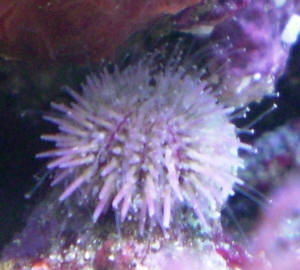 |
|
Unknown Creature: Sea Cucumber -- 2/8/10
Hi everyone, I'm Mike in the UK.
<Hello Mike, I'm Lynn - near Seattle, Washington.>
I've had my first reef tank up and running for 20 weeks now
and to much success.
<Great>
I use your site often when help and views are needed as I
gradually learn on the lower end of a learning curve, and I find
it excellent. The reason I'm writing is that I'm trying
to identify a creature that came out for the first time yesterday
where I was able to take a photo (of which I have attached).
<Neat!>
The creature used to live in some porous rock and I could hardly
see it.
<That's fairly typical for these little creatures. They
like to hide within rock crevices.>
At times it would produce feather-like tendrils at the end that
protruded from the rock, so I assumed it was some sort of bristle
worm that was a filter feeder.
<I can understand why you'd think that. Those feathery
tendrils ('feeding tentacles') are indeed used for
filtering bits of particulate matter out of the water column. The
neat thing is that the tentacles work independently, instead of
as a group. When one captures a bit of food, it curls in on
itself, taking the food to the animal's mouth, then unfurls
back into its original position. What you have is a neat little
filter-feeding Holothuroid, or sea cucumber. The small
projections you see around the body of the animal are tube feet.
The Cuke uses them to secure itself within a hole/crevice, to
pick up bits of shell, etc., for camouflage, and for locomotion.
All in all, these are interesting and mostly harmless little
creatures. The only real worry with Cukes is their potential for
toxin release when threatened or dying (aka the dreaded 'Cuke
nuke'). Some are more toxic than others and risk increases
with large Cukes in small volumes of water. Thankfully, I
don't think you have too much to worry about with this
individual since it's so small. I would leave, and enjoy it.
Please see the FAQ's at the following link for more
information, particularly the one titled 'Anemone Id? Nope,
It's A Cuke! 8/10/07':
http://www.wetwebmedia.com/cukeidfaqs.htm >
However after seeing it this morning I'm not sure. It is
approx. 2.5 cm long and 0.5 cm in diameter. It reminds me of a
moth caterpillar.
<Me too. One thing I'd like to add that's completely
unsolicited is that I noticed in your photo that you've got
quite a growth of Caulerpa on your rocks. The stuff can be a
challenge to control but it can be done. Please see the following
links for more information re:
http://www.wetwebmedia.com/caulerpaalg.htm
http://www.wetwebmedia.com/caulerpacomp.htm >
I look forward to your reply and thanks for a great and
informative site.
<You're very welcome. Enjoy the Cuke! LynnZ>
|
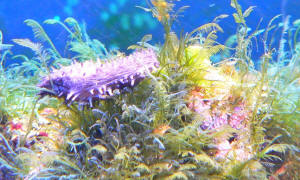 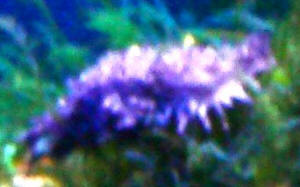 |
|
Re: Unknown Creature: Sea Cucumber --
2/9/10
Thanks Liz for the ID.
<You're very welcome, Mark. Heeee! Sorry, I couldn't
resist. I know your name is Michael. My first name is actually
Lynn, but no worries. Liz is close enough.>
I will read up on these creatures now. No wonder I could not ID
myself as I was looking for it under the illusion that it was
some kind of bristle worm.
<That's understandable. They're also occasionally
mistaken for Nudibranchs/sea slugs.>
As for the Caulerpa, it's gradually coming under control.
<Oh good! I've battled the stuff myself so I know what a
challenge it can be to eradicate.>
I manually remove some each week prior to water change and
regrowth is becoming less.
<Excellent. The trick is to get all those runners picked off
of the rocks. That's about a negative 150 on the fun-o-meter
scale!>
I've already battled and won through persistence and routine
maintenance an outbreak of red Cyano on the substrate and a green
hair-like Cyano that attached to my LR.
<Good for you! That stuff is the scourge of the hobby.>
The Caulerpa doesn't stress me half as much as those two
did.
<I can certainly understand that. One thing that could really
help here is a competing, favorable macro-algae kept in a
refugium/sump. I don't know if you have this, but if not,
it's worth considering.>
Thanks once again for the help :)
<It was a pleasure. Take care, LynnZ>
|
|
Nudibranch or Cucumber? Nudibranch: Likely Tritoniid
-- 9/22/09
Hello Crew!
<Hello, Tim!>
Can you identify this marine invertebrate for me please?
<I'll sure try!>
It was a hitchhiker on my liverock. I'm not sure if it's
a Nudibranch or a cucumber.
<It looks like a neat little Nudibranch rather than a
Cuke/Holothuroid but I can certainly understand the confusion.
Both have species with similar body shapes and branched
structures around the head/mouth. In the case of Holothuroids,
those structures are actually branched oral tentacles used for
feeding, and typically number anywhere from 10-30. In comparison,
Nudibranchs have oral tentacles along with two 'antennae'
called rhinophores. Both tentacles and rhinophores can range in
appearance from simple to highly branched/ornate. I think what
you have is a Nudibranch in the suborder Dendronotina, family
Tritoniidae. Tritoniids feed on soft corals (especially Xenia),
so if you have any in your system, I'd remove this little
guy. If you'd like to pursue this ID further, please see the
following link for a list of species in the above-mentioned
family (each is a link with more information/photos):
http://www.seaslugforum.net/specieslist.cfm
Start with the genera Marionia and Tritonia. The genus
Marionopsis is also a possibility, but not listed (try a Google
or other search engine). You might also want to check the family
Bornellidae as well (at the above link). There are some
similarities around the head but the structures
('cerata') running along either side (down the back) tend
to be simpler in shape (less delicate and finely
branched).>
Thank you for the help in advance,
<You're very welcome -- that's a neat little
critter!>
Tim
<Take care, LynnZ>
|
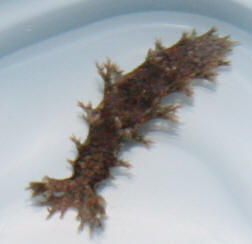 |
|
Hitchhiker ID: Rock-Dwelling Sea Cucumber --
6/17/09
Hi again,
<Hello Elfrieda, Lynn here today.>
Another puzzler for me....6 months into the set-up of my 24gal
Aquapod w/ metal halide light. It appears to be some sort of worm
perhaps???
<Actually, what you're seeing is the feeding apparatus of
a rock-dwelling sea cucumber/Holothuroid. For more information,
please start with the FAQ's titled 'Please help to ID:
Sea Cucumber -- 6/1/09' and 'Anemone Id? Nope, It's A
Cuke! 8/10/07', located at the following link:
http://www.wetwebmedia.com/cukeidfaqs.htm . Please also note
links within the two FAQ's.>
The second time I've seen it on the same rock....and the last
picture is just before it disappeared.
<Nice photos!>
Thanks so very much for your time.
<You're very welcome>
Elfrieda
<Take care, LynnZ>
Re: Hitchhiker ID: Rock-Dwelling Sea Cucumber --
6/17/09
<Hi Elfrieda>
Another look at this stranger....
<Neat!>
Its tentacles appear to be catching food and one by one are drawn
into its 'mouth'.
<Good observations - that's exactly what it's
doing!>
Thanks again,
<You're very welcome>
Elfrieda
<Take care, LynnZ>
<<A nice short video clip... that RMF doesn't know how
to add to WWM...>>
|
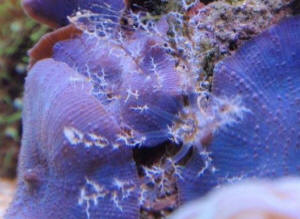
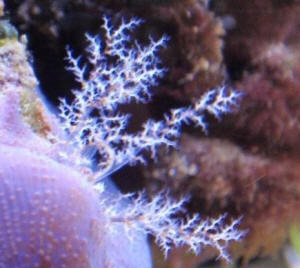 |
|
Sea Cucumber ID -- 03/07/09 Hello Crew, This
came to me as a hitch hiker a few years ago and has remained
hidden most of the time. I saw it again a few nights ago and
snapped these pics. When I do see this Cucumber, it is after the
lights are out and he is climbing to the top to filter feed. I
hope the pics help with an ID. Thanks, Rick Emery <Do
indeed... I think you have a Tiger Tail Cuke, Holothuria
thomasi... and it is presence is testament to your steady,
careful maintenance. Congrats! Bob Fenner>
|
 |
Re: Sea Cucumber ID 3/8/09
Thanks for the reply Bob. My wife and I were thinking Holothuria
impatiens, what are the differences? <Mmm, might be... do you
know the origin of your live rock? If Atlantic, or S. Pacific, this
would tell> Also, we wanted to say thank you for the speech on
Cnidarians when you visited our Reef group (AZ FRAG) in Phoenix
last summer, it was very informative, and we look forward to you
visiting again. Thanks, Rick Emery
<Thank you Rick. Bob Fenner> |
|
|

